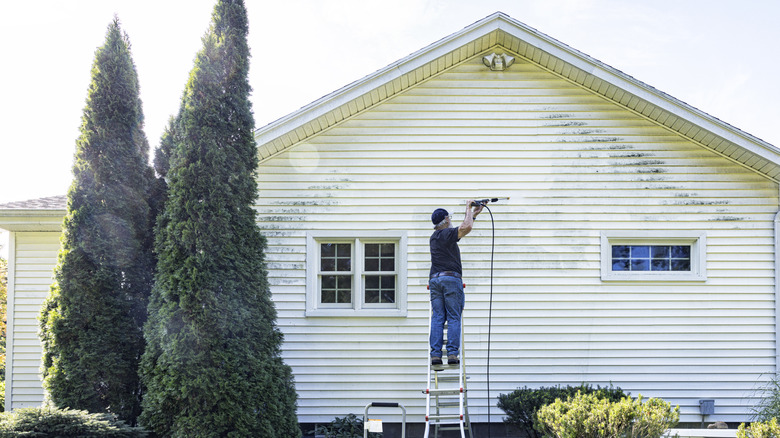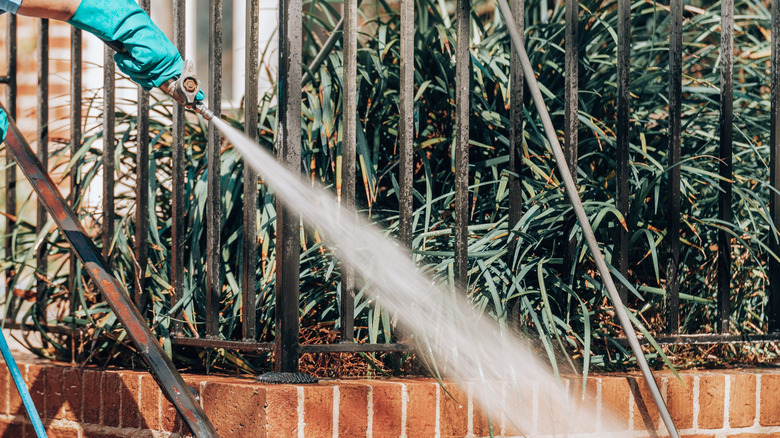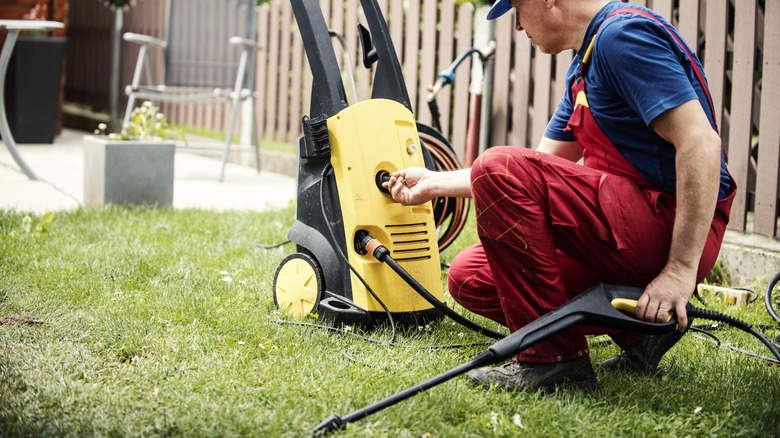Ditch Pressure Washing. Here's How To Soft Wash A House
As satisfying as it is to watch a pressure washer blast away grime, not every situation calls for brute force. That's where soft washing comes in handy. Soft washing uses a pressurized nozzle too, but it's much lighter and more gentle, making it safe to use on all kinds of house exteriors — which is not the case with pressure washing.
Pressure washing works well on hard surfaces like sidewalks and driveways, as well as most vinyl siding. But it produces enough force to cut skin and could damage delicate materials like brick or stucco, as well as any weakened areas in your house's exterior. It can remove paint from certain surfaces and injure plants growing along the house. Unsurprisingly, the cost of making a mistake can be huge. For example, it's all too easy to cause accidental damage when pressure washing your house by using the wrong nozzle or holding the washer in one spot for too long.
That's why it's generally better to start with the gentlest cleaning method possible before you jump to a high-pressure wash. Soft washing uses pressures below 500 PSI (pounds per square inch), whereas pressure washing may use around 2000 to 3000 PSI. Also, while pressure washing typically relies on water alone, soft washing uses a cleaning solution with bleach, soap, or both, which is ideal for killing mold or algae. The soft washing process is far less risky yet still reaches every nook and cranny of your house, so there's really no wrong time to soft wash instead of pressure wash.
Soft washing prep and supplies
The best time to soft wash your house is on a sunny day with temperatures between 40 and 75 degrees Fahrenheit or so. This ensures that the cleaning solution doesn't evaporate before it does its job, nor that there's any risk of a freeze. Usually, spring or fall will work well. You still need a pressure washer to soft wash your house, but you'll need to get a soft wash nozzle that's compatible with the device. You can buy a cleaning solution for home exteriors at a home improvement store or mix your own with water, bleach, and liquid soap. You also need gloves and safety glasses, and potentially a ladder for high areas.
First, prep your house for cleaning by removing any objects from the outdoor area that could get wet or damaged by the cleaning solution. Protect your plants by covering them with a tarp, or move them out of the vicinity. Make sure all of your doors and windows are securely closed. Then mix your cleaning solution if necessary: 1 part bleach to 1 part water, plus 2¾ cups of liquid soap per gallon of solution. Using your washer, apply the cleaning solution to your house one section at a time, working from side to side and from the bottom up to prevent streaks.
Tips and finishing touches
Let the cleaning solution sit for a bit, but don't let it dry. Using the soft wash nozzle, go back in with plain water to rinse the solution away. Work in the same order and direction that you used to apply the solution. Technique is key when soft washing your house: don't bring the nozzle closer than a foot to the surface, and try to maintain an 85-degree angle. Avoid spraying directly toward windows or door frames. You can repeat the washing process for any stubborn areas; otherwise, you're all done.
If you're wondering how often to wash your home's exterior, once every year or two is a safe bet. You may need to do it more frequently if you live in an area with lots of salt, pollen, or leaves in the air. A close look at the state of your house will tell you if it's in need of a wash.
If you don't own a pressure washer, a regular garden hose also works fine for cleaning your house (and is even gentler than soft washing). To reach high areas, you'll need a ladder and/or a telescopic brush with a long handle. Home improvement stores also sell DIY siding cleaning kits. However, if you're not confident, don't risk it. Sometimes it's smarter to hire a professional to wash your house for you, particularly tricky areas like the roof.


